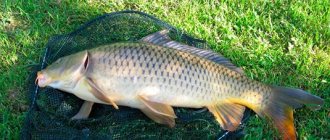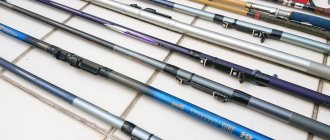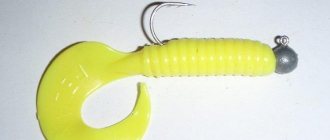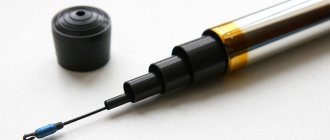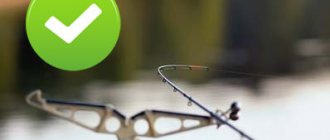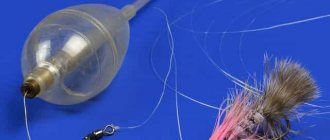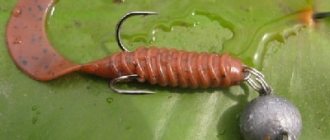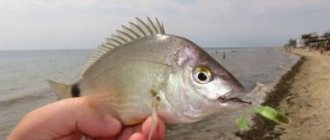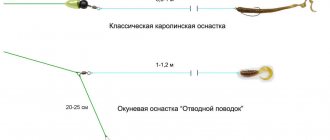Pros and cons of using gear
The advantages of bottom spinning rods are:
- Possibility to fish at great depths and at a distance from the shore (about 100m).
- The ability to combine fishing with the process of feeding.
- Possibility of fishing in reservoirs with strong currents.
- The ability to control the fishing process using a signal system in the form of sound and visual devices that respond to the slightest touch of fish to the bait.
The disadvantages of using donks include attachment to a specific area of the reservoir and labor-intensive removal of prey and all gear at the end of fishing.
Bait and its principle of operation
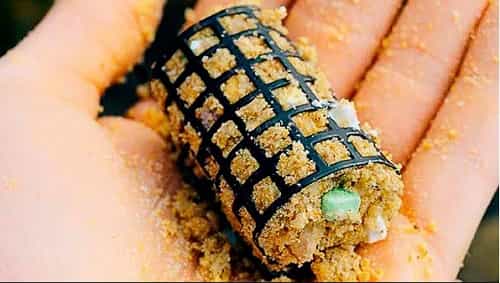
There are many recipes for preparing bait mixture. The main properties are viscosity, due to which leaching from the feeder will occur evenly, within 5-10 minutes. If the bait is too viscous, then after 10 minutes it will still be inside the cage. This is a huge mistake for beginner bottom fishers.
Because of this, the fish, when they come to the smell, do not find anything edible and quickly leave the fishing spot. If the bait is washed out, then a bait spot is created, and the fish swims up and begins to actively feed, staying at the point. The contents of the cell and its fraction are very important. The fish should not eat its fill, as it will then leave the feeding area.
Ideally, successive feedings would be enough to keep the fish in the fishing spot, but at the same time without feeding it. The small fraction is used when fishing for silver bream, roach, and crucian carp. The large food fraction is used when fishing for carp, bream, ide and other trophy species, otherwise it will not linger in the swim. There are various liquid additives that help speed up the digestion of fish. In other words, no matter how much she eats, she still won’t be able to get enough.
Donk equipment
Thanks to the naturalness of the baits located on the bottom and the design features of the tackle, donks are characterized by enviable catchability.
Donka consists of the following components:
Spinning rod , about 2 m long (or fishing rod). Tip: the length of the spinning rod must meet the angler’s requirements, taking into account the distance of casting the feeder from the shoreline or boat. The optimal length is about 2.5 m.

Inertia-free reel (spool size 3000). Advice: You should choose a multifunctional reel in order to prevent unforeseen situations with the main fishing object - large predatory fish.
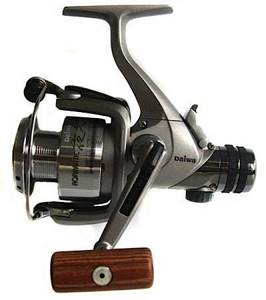
Monoline , 100m long and about 0.3mm in diameter.
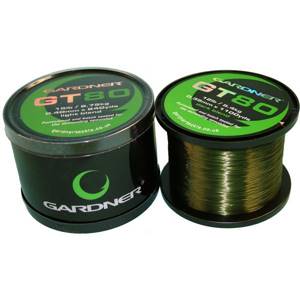
Lead line , 20 m long and about 0.2 mm in diameter.
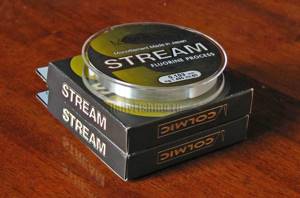
Feeder sinker , weighing 40–100 g (weight depends on the type of fish). Advice: for each reservoir, the optimal feeder is selected based on color, weight, type of bait, but it is recommended to stock up on a variety of types during fishing.

Hooks of appropriate sizes (No. 6, No. 7, No. 8). Advice: in any situation it is necessary to have a set of leashes with different sizes of hooks and thickness of fishing line, since it is impossible to predict the bite.

Bite alarm (electric device, bells, floats, etc.).
You can learn how to make a bite alarm with your own hands from our article.
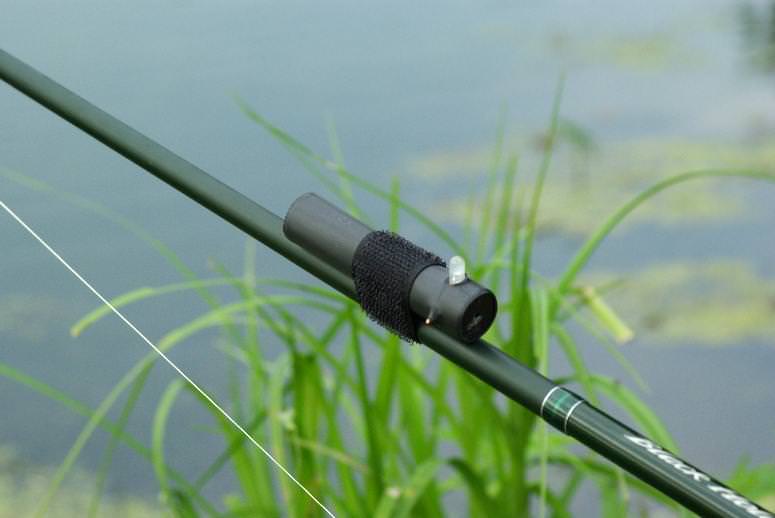
A reliable stand for a spinning rod that can withstand jerking fish.
The number of leashes depends on the type of feeder and is standard 2–5 pieces.
Sinker for donkey
Continuing the topic of assembling the donkey, I would like to express my opinion as to which sinkers are preferable to use in the middle reaches, provided that the river bottom is not uniform, but has stones and irregularities. Of course, I am clearly and clearly aware that my notes in no way claim to be absolutely right, accurate and correct, but for about 4 years now I have been fishing using this method and achieving quite good results in comparison with my colleagues who fish in the usual way. It is enough to go to any fishing store, where you will be competently advised on the method of setting up any bottom gear and the method of selecting gear. It’s no secret that the final result when fishing from the bottom is influenced by everything: bait, the size and shape of the hooks, the length of the leader and the diameter of the fishing line, both main and leader. It is important to understand that even the rod itself and the method of fixing the bite play an important role.
A separate topic is sinkers, which can be of different shapes, perform the function of a feeder and many other functions. But I noticed that in moderate currents the weight of the load can be reduced somewhat without damaging the gear. But if this is done by simply replacing the sinker, then such a load will simply be carried away by the current, it will roll along the bottom, even if the latter has irregularities and protrusions. In this case, you will have to return to a heavier sinker and be content with what you have. Accordingly, at one time I thought that it was necessary to give the sinker properties so that it could, as it were, cling to the protrusions of the bottom and lie on it.
So, if you use a sinker attached to the bottom tackle at the end of the fishing line, and hooks are located above, if you know that there are stones at the bottom, the bottom is sandy or has frequent protrusions, then instead of a heavier load you can put a lighter weight, but round in shape with "donut hole" This hole will act as a retainer, and a fairly reliable one at that; the sinker will not be carried away by the flow of the current, since the area of contact of the water with the surface of the load is smaller. Thus, I managed to reduce the weight of the sinker from 50 grams to 35, which, you will agree, is significant. It seems to me that this will be useful for many fishermen.
Donkey installation
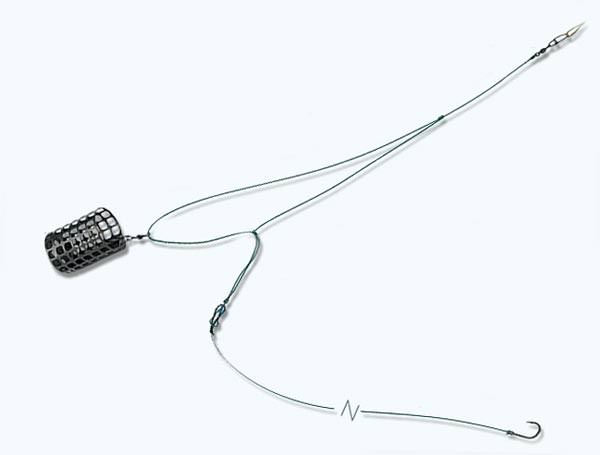
To design a donkey, you must follow the structure assembly algorithm:
- Assemble the rod and firmly secure the reel with guide rings, placing them in one row.
- Wind the fishing line onto the spool and bring it through all the rings of the rod, after which a knotted loop is formed at the very end of the fishing line.
- Drop the line guide bracket and attach the line to the spool.
- Wind the line onto the reel.
- A sinker-feeder is attached and fixed to the main fishing line, after which a second knot loop is formed at the end of the base.
- Attach one leash with a hook and additional equipment if necessary to the last knot loop.
- Install a fishing rod stand with a bite alarm.
Tip: to securely attach hooks to leashes, the most efficient way is to use knotless fasteners.
With the help of a donkey, it is possible to study a reservoir by moving along the coastal line.
Donkey fishing is carried out in several stages:
- Assembly and installation of the fishing rod.
- Casting a sinker with a feeder attachment.
- Carrying out hooking after the first bait.
- Catching fish by winding fishing line onto a reel.
Methods for equipping a donkey
Now I will give a couple of ways to rig bottom gear:
As you can see, the basic recommendations and schemes are quite simple. But I promise you, doing them will ensure that you end up with fish (it works for me anyway). Naturally, each fisherman has his own experience and knowledge, you also need to remember about the correct installation of the donkey, and constantly experiment. Then the mood will be great. And fishing will please you with its results.
Feeder installation options
The options for installing feeders are very diverse, but there are several main ones:
- Installing a tube with an anti-twist.
- "Paternoster" (Gardner rig).
- Loop systems (symmetrical, asymmetrical).
- "Nipple spring."
- "Makushatnik."
Installing a tube with an anti-twist is the least complicated option for installing feeders, in which the fishing line is passed through the curved cavity of the tube and secured with a bead or other convenient method. At the bend there is a swivel with a carabiner for quick replacement of the feeder.
“Paternoster” is a popular type of installation, characterized by the formation of a loop from the main fishing line, onto which a swivel with a carabiner is first threaded to secure the feeder, and a second loop at a distance of 20-30 cm for attaching a leash. This method of equipment is relevant for standing reservoirs with a muddy bottom.
Tip: to determine the bottom topography, you should use marker floats.
The use of loop systems involves the use of loops of asymmetrical and symmetrical design, from which a knot loop is formed for mounting a leash with a swivel. Effectively used in standing reservoirs and in currents.
The installation of a “nipple spring” with its inherent placement of bait on a hook, which is swallowed by a fish, is as follows:
- A spring feeder is attached to the main fishing line, and rubber stops in the form of pellets or beads are installed.
- Fastening the leashes with hooks around the circumference of the entire spring at the same distance from each other.
- A bait attachment, the type of which is dictated by the type of fish being caught.
Fishing tackle of the “makushatnik” type is manufactured according to the following sequence of actions:
- A sinker is threaded onto a line with a diameter of 0.4–0.6 mm and secured with a knot.
- A swivel is attached to the free end of the fishing line.
- Behind the swivel, a piece of topcoat is placed, which is also secured with a knot.
- At the very end of the fishing line, a fastener with leashes is installed.
- Pressing the hooks into the above piece of topcoat.
In addition to typical variations, feeders vary in shape and weight, due to the heterogeneity of fishing conditions:
- Thus, for standing reservoirs, feeder traps (such as “paternoster” and loop systems) with a short leash and light weight are used.
- For rivers, feeders with a flat lid or in the form of a cylinder are used.
- For reservoirs with fast currents - with a rectangular lid and a relatively large weight (maximum 60 grams), which allows you to evenly scatter the food along the bottom.
- For slow-flowing reservoirs, it is optimal to use cylindrical feeders with a built-in control valve system for dosed feed supply.
- A cone feeder is suitable for lakes and deep areas, the shape and design of which is indispensable when catching large species of fish.
Tip: the most productive for any pond are flat feeders with a lot of weight.
How to make a donka with a feeder
As mentioned above, the basis of the gear is a spinning rod with a spinning reel. For bottom fishing, the required amount of cord is selected based on its length of at least one hundred meters. Cord thickness is from 0.12 to 0.3 mm. The installation of the equipment is attached to the fastener of the main cord, and, if necessary, is knitted at its base.
To correctly make a donk with a feeder allows the fisherman to know and be able to tie various types of feeder equipment. The most effective and simplest to implement is the paternoster equipment. It is knitted from two loops, to one of which the leash is attached, and the other is used for mounting the feeder itself. The versatility of the tie allows you to fish in most conditions.
The loop system is characterized by the same universality of execution. Its two varieties in the form of a symmetrical and asymmetrical loop give the angler the opportunity to fish with active - the first option, and passive - the second, fish. The option of using an anti-twist or a rocker allows you to completely avoid tangling the equipment and is recommended for beginning anglers to gain experience in bottom fishing. The main fishing line is passed through the tube, to the end of which a leash is attached, and the feeder itself is mounted to the short arm using a fastener.
All installation methods presented are knitted directly on the pond, they do not take much time and require the least amount of elements. For these types of installation, the feeder on the bottom is suitable in both open and closed versions.
Technique for fishing with a spinning rod and a feeder
When fishing for a certain type of fish with a feeder, you should take into account the underwater current, which can significantly expand the radius of passage of fish from the place where the donkey is cast. Casting is carried out taking into account the habitat of the fish species of interest. So, when fishing for bream, which prefers places far from the coastline, casting as far as possible is effective. For carp, constant bait is required in a certain place to keep it in this zone for the required time.
The following stages of fishing are distinguished:
- Preparation of bait (saturating it with moisture for 20-30 minutes).
- Carrying out depth measurements in the planned area of the reservoir.
- Starting casting of feed with a feeder.
- Donk fishing with constant bait every 10-15 minutes.
- Hatching fish immediately after starting feeding.
- Fishing.
Advice: you need to change the fishing location if the fish are not biting within the first hour after the starting cast, or change the bait.
The groundbait used for donkeys must contain a base (of plant and (or) animal origin), flavorings and aromas. Dry cereals are suitable as a base: semolina, millet, pearl barley and other plant components, viscous mixtures of which can remain at the bottom for a long time, gradually being washed away by the internal current. The bait itself must be of animal origin (selected depending on the preferences of the fish and the ability to stay on the hook): worms, leeches, etc. While playing an attractive role, the bait should not be more nutritious than the bait.
Bottom depth measurements are carried out using a marker float and sinker, which are attached to the line of a spinning reel. This type of bottom depth measurement is effective for standing reservoirs. If there is a current, you should take care of a heavier sinker and a voluminous float that can resist the current and float above the sinker for the most accurate measurements in the planned area of the reservoir.
The main role of the starting cast with a feeder is to initiate the process of feeding the selected place (about 7-20 casts with an interval of 10-15 minutes each) with a loosely filled feeder to wash out the bait more quickly, which will ensure a productive process of bottom fishing. Advice: having determined the optimal consistency of the feeding, the contents of the feeder should be enough for 10 minutes, and even less when starting casting.
After biting the bait, the fish often hook themselves onto sharp hooks with bait. Fish should be brought to the shore in a clean area of the reservoir: without vegetation and snags, where you can miss the prey and not complete the process of tiring it out. Advice: most species of fish caught on a hook are very active when they rise to the surface and can tear off the tackle, so it is recommended to pull the fish to the water’s edge and, tiring, smoothly bring it to the shore.
Bottom fishing, which does not require special attention, is very popular among amateur fishermen; moreover, fishing can be done around the clock, in any weather, both from the shore and from boats. Another advantage of using donks is that the bait can be cast over long distances and at different depths. Being located on the bottom, this type of bait looks the most natural and does not scare away the fish, which is often typical for fishing with the help of floats.
Fishing strategy, complementary foods, bait
Bottom tackle with a spinning feeder is best used on an open, clean and unovergrown bank. Trees and bushes will only hinder the process. It is also better to choose a place with a flat, flat bottom. Then the bait casting range is selected, a visual reference is determined, the fishing line is attached to the reel, and the fish is baited. During the feeding process, up to fifty portions of food are located in the same place, which will create a truly dining table for prey. Then the fishing process begins. The feeder is changed to a catch one, then cast and patiently wait for a bite, the presence of which is monitored by the alarm. The bite is followed by an immediate hook and reeling of the line. A net is used to catch fish from the water.
Complementary food is used commercially (it is diluted to the desired density), bloodworms, maggots and chopped worms work well. Additional flavorings are added to the finished food - garlic, vanilla, anise, cinnamon. Complementary foods quickly lose their appeal and change frequently.
Live and plant products are excellent for bait. Frequently changing baits from one type to another has worked well to increase the bite.
Live baits include:
- worms;
- beetles;
- flies;
- maggots;
- bloodworm.
Plants include:
- porridge;
- corn;
- bread;
- peas;
- dough.
Donka with a feeder is used throughout the fishing season in open areas in both warm and cold water. This method is very effective, even if the fisherman is not very experienced in fishing.
TAGS:
Blitztips
- Advice: when fishing using feeders, the bait must be higher in taste than groundbait, which underlies the catchability of the gear.
- Tip: in order for the line to withstand the load when casting the feeder, you need the correct ratio of the radius of the line and the weight of the feeder sinker. To maintain balance, it is enough to insert a thicker thread of fishing line, about 5-10 cm long. This auxiliary part is also called a shock leader.
- Tip: when fishing with a spinning rod with a feeder, it is very important to stock up on sharp hooks to quickly hook fish while feeding.
- Advice: for fishing, it would be useful to have backup sets of hooks, feeders, sinkers, and spools of fishing line of different sizes, weights and diameters, respectively, which will prevent disruption of the fish hunt.
- Tip: experienced fishermen make successful hookings by carefully monitoring the nature of the oscillatory movements of the built-in signaling system: the slightest change in rhythm is a signal for immediate action.
What elements does the tackle consist of?
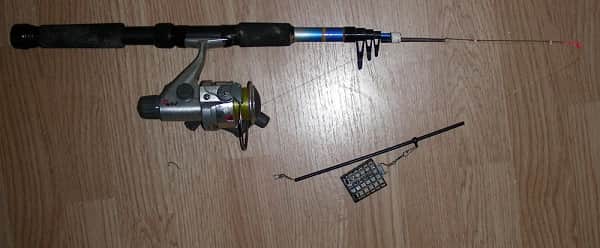
Assembling the gear is not difficult even for a novice fisherman. It requires very little installation and is inexpensive. Read below what we need for this:
- Rod . An excellent option would be the simplest and cheapest spinning rod (telescope) or an affordable feeder rod - their brands and production do not matter. It is important that the test be from 40 g and above, the running ones are 40-60 g with a length of 2.1-2.7 m. In the presence of a large current, the test is increased to 100 g. The test means what the total mass of a feeder filled with bait should be. Do not overload the rod again, this will lead to breakage of one of the legs.
- Reel _ Inertia-free will come in handy. The optimal spool size is from 2500 to 4000; most often, size 2500 is enough; it can hold 100 meters of fishing line. It is desirable to have a friction brake in the “meat grinder”; it will be extremely useful when fishing for large specimens of carp or carp. Preferred does not mean required, choose according to your budget.
- Main line . Braided cord is often used as the main fishing line, since with a smaller diameter it has a higher breaking load. The diameter of the braid is 0.10-0.12 mm. For monofilament 0.16-0.20 mm. In the case of fishing on paid sites (where the chance of catching a trophy increases) use 0.30-0.35 mm.
- Feeder . It is selected and equipped depending on the fishing method and the chosen location. For the current, choose a larger mass (100 grams or more together with food) of a rectangular shape. For standing water, 40-60 g is enough, any shape is possible: rectangular, round, without corners, etc.
- Hooks . They are selected depending on the type of fish on which the emphasis is placed when fishing. The most popular are No. 10-14 (roach, bream, bream) with a short shank, this is an excellent option for fishing with pearl barley or maggot. When fishing with a worm, choose a hook with a long shank No. 6-8; if it has several barbs on it, even better. The long forend is convenient because the worm fits perfectly on it, and the notches prevent it from slipping off the hook.
- Retractable leash . It is important that it be smaller in diameter than the main line. Materials: monofilament with a diameter of 0.10-0.12 mm, fluorocarbon with a diameter of 0.12-0.13 mm. Thanks to the retractable leash, the tackle becomes more delicate (thin, invisible). Its length varies from 0.5-1.5 meters, depending on the caution of the fish and the current. The more careful the fish and the stronger the current, the longer the leash is needed.
- Bite alarm . Convenient because when using it there is no need to closely monitor the tip of the rod. It can be in the form of a simple bell, or electronic, with tension sensitivity settings.

